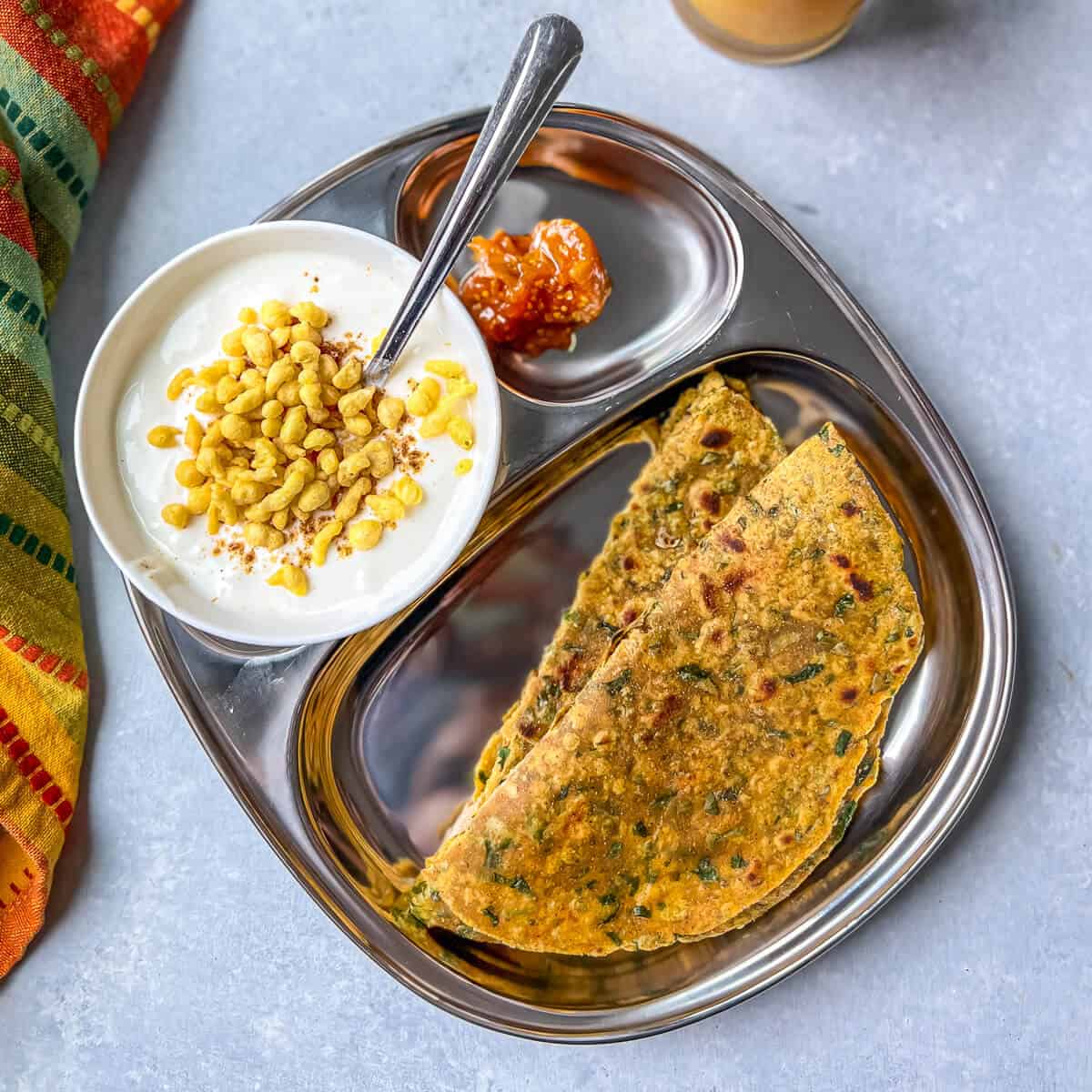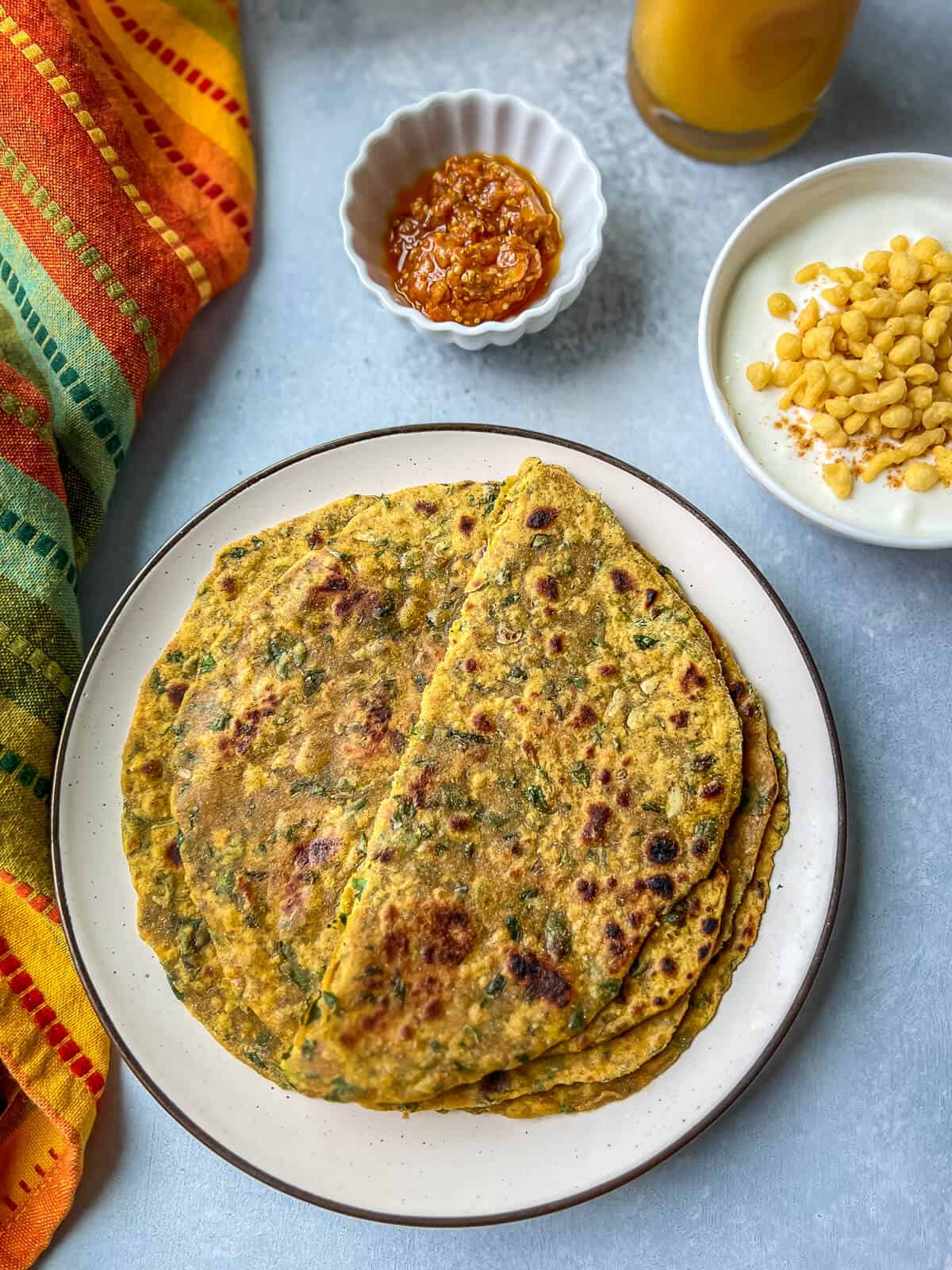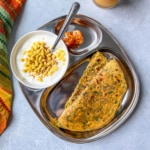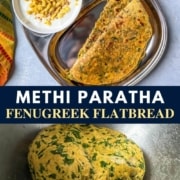This flavorful methi paratha or methi roti makes the proper savory breakfast, snack, or lunch accompaniment. The fragrant methi leaves make these healthy parathas a gastronomic experience that you just won’t soon forget.

Paratha is a highly regarded North Indian flatbread that features flaky, ghee-slathered layers and a crispy texture. Growing up in a South Indian family meant I at all times had my Mother’s homemade idlis in my school lunch, but I’d swap my North Indian friends for his or her parathas if I had the chance.
Whether it’s the usual plain paratha, or a flavorful and failproof aloo paratha, these flaky Indian flatbreads are one in every of my favorite things to eat for breakfast, snack time, and even a college or work lunch.
This recipe for methi paratha is a savory, flavorful, and delicious variation that features freshly chopped methi leaves, garlic, and spices. Serve it with butter and a side of pickle for a straightforward breakfast or alongside a creamy paneer curry for a whole meal.
What’s methi roti / paratha fabricated from?
Methi roti (or methi paratha) is made using a basic plain paratha base, which incorporates whole wheat flour, water, salt, oil (avocado or vegetable), and melted ghee. Along with the essential dough, freshly chopped methi leaves, garlic, and spices are added to offer a delicious and savory flavor.
Reasons to like this recipe
- These soft Indian flatbreads are made with whole wheat flour, meaning they’re a healthy alternative for on a regular basis meals.
- Long shelf life – it won’t go bad without refrigeration for 2-3 days, making it perfect for travel.
- Easily adapted to be vegan – swap the ghee for oil.
- Perfect for any time of the day. Enjoy it for breakfast or pack it for lunch, together with raita and/or a cup of piping hot masala tea.
Advantages of fenugreek leaves
Fenugreek (pronounced feh·nyu·greek) leaves have a rather bitter taste and are just like fennel or celery leaves in flavor. The Hindi word for fenugreek is methi, and that is what it’s referred to in India, where it is usually utilized in quite a lot of dishes.
Fenugreek greens have long been utilized in traditional medicine, they usually contain a number of health advantages. Listed here are a couple of of the various advantages that methi has to supply:
- Helpful for diabetes – The amino acids in fenugreek stimulate insulin secretion and increases insulin sensitivity. This helps to control glucose levels.
- It helps control cholesterol by increasing good cholesterol and reducing the discharge of bad cholesterol.
- Weight management – Fenugreek leaves are high in fiber, which keeps you satiated and helps control cravings.
- High in antioxidants which helps prevent cell damage.
Read more: Advantages of fenugreek leaves
Fenugreek, along with its Hindi word methi, is thought by quite a lot of names throughout the world. This includes bird’s foot, Greek clover, alhova, fenogreco, chandrika, woo lu bar, bockshornklee, Greek hay, and plenty of others.
Easy methods to clean methi leaves
Fresh fenugreek leaves are likely to have mud within the roots. The best solution to clean them is to remove the roots and pluck the leaves from the stems. Then clean the leaves and rinse them several times until the water runs clear. This can handle any remaining mud.
Methi paratha vs. methi thepla
For those who’re accustomed to methi thepla, you might be considering that this methi paratha recipe sounds very similar and maybe could even be the identical. While it’s true that the 2 are similar, they’re different in several ways.
- The important thing difference is that methi thepla at all times uses yogurt, while this ingredient is just optional when making methi parathas.
- Paratha is just made with whole wheat flour, whereas thepla is made using besan (Bengal gram flour) or bajra (millet).
- Methi thepla also calls for more ingredients, including sesame seeds, fennel seeds, and ginger.
- The dough for methi paratha is made with water which yields a soft dough, while thepla has a firm dough made with plain curd or yogurt.
Methi paratha or fenugreek paratha recipe can also be known by the next names:
- Methi ke paratha
- Methi ka paratha
- Methi chapati
- Punjabi methi paratha
- Kasoori methi paratha
- Methi roti
Here’s what you must make the recipe

You’ll need the next equipment to make parathas

Click on the celebs to rate!
Methi Paratha recipe
This flavorful methi paratha or methi roti makes the proper savory breakfast, snack, or lunch accompaniment.
For the dough
- 2 cup methi leaves, finely chopped
- 3 cups whole wheat flour
- 3-4 garlic cloves, minced
- 1 teaspoon Kashmiri chili powder
- ½ teaspoon turmeric powder
- 1 teaspoon coriander powder
- 1 teaspoon carom seeds (ajwain)
- 1 teaspoon fennel seeds (saunf)
- 1 teaspoon salt
- 2 tablespoons oil (avocado or vegetable) + 1/4th teaspoon oil
- 1.75 cups water or as needed, at room temperature
For rolling out
- ¼ cup whole wheat flour for rolling
- ¼ Melted ghee (as needed)
Prevent your screen from going dark
-
If using fresh methi, start with chopping the roots. Pick the leaves from the stems. Discard any thick stems.
-
Wash and rinse the leaves using a colander to remove any dirt residue.
-
Set the colander aside for a couple of minutes to empty water.
-
Chop the methi leaves and set it aside.
Making the dough
-
Add 3 cups of wheat flour, methi leaves, carom seeds, minced garlic cloves, chili powder, turmeric powder, dry mango powder, and oil in a big bowl.
-
Add 1 cup of water and use your fingers or a stand mixer to mix the ingredients right into a dough.
-
Add water, one tablespoon at a time, and proceed kneading until the dough comes together like a ball.
-
Add 1/4th teaspoon oil to the dough and knead till the oil is absorbed.
-
If the dough is sticky, sprinkle roughly 1 teaspoon wheat flour (or more if needed) on the dough and knead again to form a dough that shouldn’t be sticky. The dough needs to be supple and soft.
-
Cover the dough and put aside for 15-20 minutes.
- To lock up the method, roll out the following paratha as one cooks within the pan.
- Be sure that to dust off the surplus flour from the paratha before you cook it. This prevents the paratha from getting hard.
- Before storing it in an air-tight container, let the paratha cool down for at the least 5-6 minutes to avoid making it soggy.
Disclaimer: Approximate dietary information is provided as a courtesy and might vary depending on the precise ingredients/brands used. If you will have health issues, please work with a registered dietician or nutritionist.
Calories: 156kcalCarbohydrates: 27gProtein: 6gFat: 4gSaturated Fat: 0.4gPolyunsaturated Fat: 1gMonounsaturated Fat: 2gCholesterol: 0.1mgSodium: 199mgPotassium: 131mgFiber: 4gSugar: 0.2gVitamin A: 53IUVitamin C: 0.3mgCalcium: 172mgIron: 2mg
Easy methods to prep ahead
One of the best solution to prepare this methi ka paratha prematurely is to make the dough ahead of time. Follow the steps for making the dough as listed within the instructions, and when it’s time to allow the dough to rest, store it in either the refrigerator or the freezer.
- Refrigerated dough stays keeps in an air-tight container for as much as 3 days.
- The frozen dough keeps for a month.
Be sure that to bring the dough to room temperature before rolling out the parathas.
Storage suggestions
Refrigerator – When cooled and placed in an air-tight container, the rolled paratha lasts for 4-5 days.
Freezer – For those who would really like to freeze these for longer storage, they may keep for 2-3 months. Separate them with parchment paper when freezing, or they’ll stick together.
Reheat – For refrigerated parathas, reheat in a microwave (15-20 seconds) or reheat in a tava / skillet kept over medium heat. If parathas are frozen, use a tava/skillet to reheat for best results.
Variations to try
- Kasuri methi paratha – Use dried fenugreek leaves (kasoori methi) as an alternative of fresh ones. They’re stronger than fresh so use 1/2 the quantity of fresh.
- You too can use frozen methi leaves – ensure that to account for the moisture within the leaves and reduce the quantity of water used.
- Methi thepla is one variation.
- Aloo methi paratha – Boil one medium-sized potato and mash it before adding it to the dough.
- Substitute amchur powder (dry mango powder) with the identical amount of garam masala.
Other paratha recipes to try



